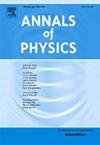弦理论中的带电Zipoy-Voorhees度规
IF 3
3区 物理与天体物理
Q2 PHYSICS, MULTIDISCIPLINARY
引用次数: 0
摘要
我们在异质弦理论的低能有效场论框架内提出了带电Zipoy-Voorhees度规的解。这个精确解表示了一个四维时空中的变形引力场,其特征是三个关键参数:质量M,电荷Q和变形参数γ,它控制着与球对称的偏差。与标准黑洞解不同,这个度量描述了一个裸奇点,这意味着它没有视界,将中心奇点暴露给外部观察者。为了检验这个时空的物理性质,我们分析了测试粒子和光子的测地线运动。对测地线轨迹的研究提供了对变形参数γ和带电参数b=Q2/2M对轨道运动、阴影和潜在天体物理观测的影响的深入了解。最后,利用观测到的M87*的阴影半径得到了电荷和变形参数的约束。本文章由计算机程序翻译,如有差异,请以英文原文为准。
Charged Zipoy–Voorhees metric in string theory
We have presented a solution for a charged Zipoy–Voorhees metric within the framework of low-energy effective field theory for heterotic string theory. This exact solution represents a deformed gravitational field in four-dimensional spacetime, characterized by three key parameters: the mass , the electric charge , and the deformation parameter , which controls deviations from spherical symmetry. Unlike standard black hole solutions, this metric describes a naked singularity, meaning it lacks an event horizon and exposes the central singularity to external observers. To examine the physical properties of this spacetime, we analyzed the geodesic motion of test particles and photons. The study of geodesic trajectories provides insight into the effects of the deformation parameter and charged parameter on orbital motion, shadow, and potential astrophysical observables. Finally, a constraint on charge and deformation parameter using observed shadow radius of M87* has been obtained.
求助全文
通过发布文献求助,成功后即可免费获取论文全文。
去求助
来源期刊

Annals of Physics
物理-物理:综合
CiteScore
5.30
自引率
3.30%
发文量
211
审稿时长
47 days
期刊介绍:
Annals of Physics presents original work in all areas of basic theoretic physics research. Ideas are developed and fully explored, and thorough treatment is given to first principles and ultimate applications. Annals of Physics emphasizes clarity and intelligibility in the articles it publishes, thus making them as accessible as possible. Readers familiar with recent developments in the field are provided with sufficient detail and background to follow the arguments and understand their significance.
The Editors of the journal cover all fields of theoretical physics. Articles published in the journal are typically longer than 20 pages.
 求助内容:
求助内容: 应助结果提醒方式:
应助结果提醒方式:


